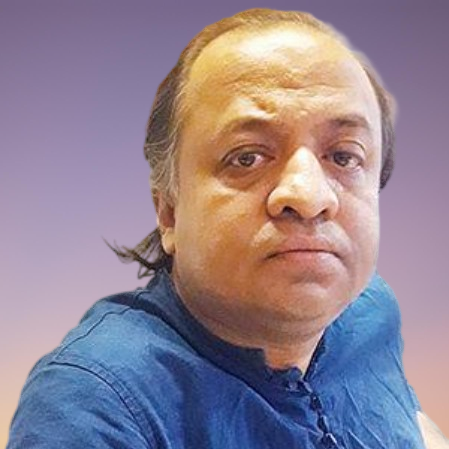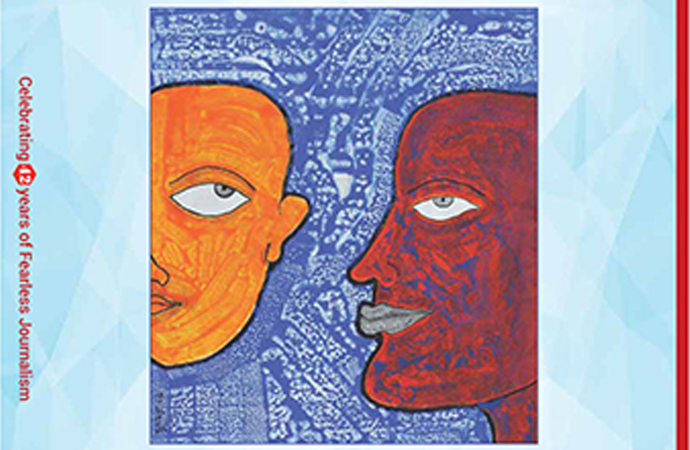Culture


Mustaque Ahmed is one of the earnest painters who has been quite active in the Dhaka art circuit since 1980s. During the period, the nation crossed many social and political obstacles and traversed a number of turmoil; our creative faculties progressed with novel dreams, ideas and premises. We have gone on to face secular democracy which quickly got confused with post-war traumas, corruption, ideological differences that often go with war ravaged countries. Intellectuals and promoters of creativities were expecting a free, liberal, non-communal and progressive atmosphere for their innovative ventures. During that period the country went through many ups and downs in all aspects. As an intense onlooker, Mustaque intimately scrutinises the transforming socio-political and economic conditions of the country. His manipulation of forms and cognizant brush strokes create a language simultaneously natural and contrived. His palette swings between mellow and bold, strokes between rugged and controlled conjuring up a visual playground for joy and ecstasy. His paintings are of inner and outer space. They intuit a complex reality that cannot be put into words. This makes Mustaque one of the most dynamic artists in Bangladesh art milieu.
With time, Mustaque continued to refine himself and harness a medley of skills, consequently, new lines, techniques, forms and different types of objects were incorporated into his paintings. Besides being a romantic and nature-focused artist, he is also a socially and politically conscious painter. He is a truly patriotic painter and has been making great attempts to highlight our Liberation War and its various aspects. The Liberation War and massacre of 1975 are some of the subjects of Mustaque's paintings which reflect his psychological temperament, anger, pain and anxiety as well as the perilous days of 1971 and 1975. His in-depth understanding of that period comes to his paintings realistically and symbolically. Mustaque's paintings look more matured due to his deep contemplation on the very roots of his subjects. In the series, he has lost himself in a sorrowful journey. The blending of light and shade creates a sense of silence and desolation in his works. Since the commencement of his career as a sensitive artist, Mustaque has been trying to convey his signature thinking process and language.
Mustaque Ahmed hails from an illustrious political family. His father is Abdur Rob alias Boga Mia - a Freedom Fighter, Liberation War organiser, businessman and president of Pabna Zila Awami League during the pre-Liberation War period. Boga Mia was a Member of Parliament (MP) and a very close associate of Bangabandhu Sheikh Mujibur Rahman. Boga was the first to hoist the flag of independent Bangladesh in Pabna district in 1971. He suddenly died in 1973 in a car accident during an election campaign. His wife Begum Jahanara Rob was an MP from Pabna and Bogura during 1973-1975 (until Bangabandhu and his family were killed).
During the massacre of 1975, Mustaque was only 18 and a student of Department of Economics, University of Dhaka. He lived in Gulshan (Road-113) and during the crisis enthusiastically went out of the house on his bike to get a glimpse of the facts. His mother forbade him to go anywhere. But Mustaque requested to go to his elder sister's house at Dhanmondi 17. On his way, he didn't face any kind of processions and protections. He felt the whole city was engrossed with panic. But when Mustaque crossed the Sobhanbagh area, he saw a bunch of people celebrating with sweets. The incident had really puzzled him. On reaching his sister's house, he met veteran politicians Abul Hasnat Muhammad Qamaruzzaman, KM Obaidur Rahman and Major Rahmatullah. All of them were very anxious. Mustaque felt deeply hurt by the killings.
On the incident, Mustaque has done two paintings (acrylic on canvas) which are theme-based, and their mode of expressions are pure narrative. One of the paintings covers the massacre of 15th August 1975. He has portrayed Bangabandhu Sheikh Mujibur Rahman's giant blood-stained figure spread across the whole map of the country on the canvas. The painting denotes the vast significance of this iconic figure. The background of the painting appears smooth and sometimes uneven, mingling the hues superbly. In producing expressions of grief from a unique perspective, he has revealed his unequalled creativity. Besides these, the painter has also depicted an emerald-green hue with a flow of red blood in the mode of impressionism. The killing was done in moonlit-night and to highlight this a melting moon is shown peeping over in the canvas. Earlier, Mustaque did a number of paintings on Bangabandhu and his life and works.
The other painting portrays some aliens (forms) flying in the air after sucking blood. The legs of the aliens are bloodstained. And the lower part of the canvas has been engrossed with a mingling of soft green and red hues. The canvas signifies a newly-born country about to feel a touch of development and economic emancipation, only to be gravely thwarted by a group of people who then departs. The killers of 1975 stopped the development of a country and, for its people, helped set up a new trajectory filled with injustice, unfairness, discrimination and religious bigotry. The painting was done in 2004 and first exhibited in 2006 in a local gallery in the city. Now, he is again concentrating on a series on Bangabandhu.
Mustaque Ahmed is very thorough in his use of ambiguous forms and the overall fundamental compositions of a painting. He meticulously uses brush for his trademark technique and the artist has experimented with layers of colours. Subdued and vivid hues have been properly applied on his canvas. His use of flat colours have created an aura where one can realise his diligence and devotion towards art. In the paintings, the spaces seem open and large, clearly emphasising each moment in time. The message in his colours can be easily interpreted by our souls and minds.
Mustaque Ahmed was the founder of the Dhaka Art Centre. He is also an avid art collector. His art collections include contemporary Bangladeshi master painters, Indian master painters, Western contemporary artists and a number of promising Bangladeshi painters. He is also a filmmaker. His documentary 'Die Million '71' received the International Bangla Film Critic Award in Kolkata. The documentary addresses the subject of genocide during the Liberation War of Bangladesh.
The writer is an art critic and cultural curator.

























Leave a Comment
Recent Posts
The forensic clean up of the f ...
Much of the coverage centring the surge in Non Performing Loans (NPLs) ...
Hong Kong’s deadliest fire in ...
Hong Kong’s deadliest fire in decades left at least 44 people de ...
False document submission hurts genuine students’ ch ..
The Missing Ingredients for Peace in Palestine
Songs of Hyacinth Boats & Hands: Reading Conversatio ..
Executive Editor Julie Pace on why AP is standing fo ..